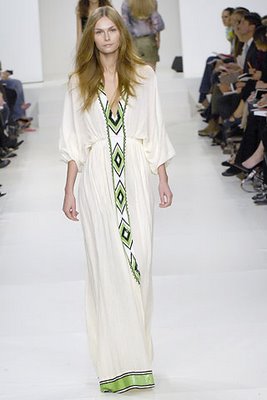 This 2007, we saw a global circulation of African fashions starting from Africa’s runways and extending to runways globally. Indeed, in our trend analysis of African fashions, we covered numerous Western and African designers cutting and shaping African prints into Western silhouettes; others incorporating African jewelries, scarves, head gears [gele] and much more in their collection. One of the designers we featured was Designer Mathew Williamson
This 2007, we saw a global circulation of African fashions starting from Africa’s runways and extending to runways globally. Indeed, in our trend analysis of African fashions, we covered numerous Western and African designers cutting and shaping African prints into Western silhouettes; others incorporating African jewelries, scarves, head gears [gele] and much more in their collection. One of the designers we featured was Designer Mathew Williamson
In a story we have been monitoring closely, the Ethiopian government has accused Williamson for what they deem the intellectual property violation of the traditional Ethiopian dress worn by their women. Click here to read the story.
Ethiopia, indeed, has been aggressively protecting itself against Western Intellectual Property infringers. See Ethiopia v Starbucks. Nevertheless, as to the issue of fashion, there are some key questions that the Ethiopian government’s allegations and investigations raise: First, I would be curious the exact origins of Ethiopia’s traditional dress. One of the things I have been surprised to discover with the launch of this blogazine is that while we talk about African prints/fabrics/designs, some of these prints/designs originated from Europe and the Europeans continue to be suppliers of their prints/designs to Africa; even though the average African wearing the European prints/designs would swear it was African. It is GREAT to see an African government trying to protect the intellectual property of its citizens.
Nevertheless, just like Western designers have done the whole “African Inspired” theme for a while now, African designers have also done the “Western inspired” theme. In fact, the big revolution in Africa’s fashion industry is taking African prints and copying the cuts, shape, style and silhouette of Western wear to create local and “international” appeal. Further, some African designers, from South Africa to Nigeria, for example, do not even bother with African prints. They use the silks, silk charmeuse, polyester, rayons, satin, jerseys e.t.c. and create the same exact Western silhouettes, embroideries/design style that has been on the runways of the West for aeons. Isn’t that stealing of “Western inspired” designs?
I think this is the bigger question. In the USA, historically, fashion designs have never enjoyed copyright protections. While you can protect your art work i.e. labels, logos, prints and the embroidery, when it comes to copying of the cut, shape, style or silhouette, “too bad so sad,” but no protection. Several rationales support congress’s reluctance to grant copyright to designs.
Who owns the original designs of the Ethiopian dresses in question? Does the action of the Ethiopian government expose African designers to liability? Will regulating “African Inspired” designs stifle creativity?
First, there is the argument that clothing is mainly functional. Most of us do not walk around with wearable art dresses. They are generally impractical. We wear functional clothes even as we stay stylish. See Barnhart v. Economy Cover, 594 F. Supp. 364 [1984] [There the Court essentially held that the Plaintiff who sued the defendant over the copying of her four human torso mannequins could not enjoy copyright protection because the mannequins were utilitarian in function, had no creative element and as such could not be copyrighted].
Second, copyright protection for designs stifles creatitvity. If a designer has to worry all the time that their designs might be seen as copying another designer and bring law suits, then there is no incentive to want to create.
Third, there is a concern that monopolies would be created in the apparel industry. Nevertheless, recently, there has been a BIG push by America’s fashion industry for Copyright legislation on designs. In fact, the bill, The Design Piracy Prohibition Act is pending in the Senate and if passed, would amend the Copyright Act of 1976 and extend protection to the appearance of a design for three years.
The issue of copyright infringement on designs some have argued comes down to the haves and have nots. I tend to think this reasoning is indeed solid. In the USA, for example, minority communities and specifically African Americans have complained, for a while now, that so called “brand name fashion designers” invade their communities through their representatives/researchers, steal their designs and replicate the exact same thing on America’s runways. For these persons and designers within those communities, their crime is that they lack the resources to execute their visions and market it to the world. Therefore, it upsets them when the big named designers copy their designs and then turn around and try to stop them from “so called” copyright infringement.
The battle of the haves and have nots? The argument by these fashionistas and designers in the Black communities across America mirrors that of African designers and indeed Ethiopia’s government. For aeons Africa’s designers have complained that Western designers descend on Africa, steal their designs and the next season, it is on the runway as so called “African inspired.” Indeed some Western designers even copy African silhouettes not just only using the prints. It remains to be seen what happens from here on but we will continue to keep a close eye on the debate and the Design Piracy Prohibition Act that we believe will significantly affect Africa’s fashion industry, especially as high end brands like Louis Vuitton pursue very aggressively counterfeiting of their designs.
~by Uduak Oduok
Founded in 2007, Ladybrille® Magazine is a California based pioneer digital publication demystifying the image of Africans in the west through contemporary African fashion and celebrating the brilliant woman in business and leadership, with an emphasis on the African woman in the diaspora. Our coverage includes stories on capital, access to markets, expertise, hiring and retention, sales, marketing, and promotions.



THIS IS VERY UPSETTING!!! Why are they talking about 'stealing' here? Any artist or designer can be inspired by any medium! And a quote I read once said that fashion is a recylcing process, no one person can claim to have invented any one style or design! Fashion goes and comes around. Simple! There is no style today that has never been made before! -maybe the collar may change or maybe the fabric may change or the color combination or something, but there would still be something that has been seen before on any design out there! never a NEW FASHION/STYLE!So what the Briton designed an 'African-Inspired' style? I use western and African medium/textiles! So, let someone sue me!! I am NOT inspired by Europen fabrics or even African fabrics alone! I just have to mix them up! That is my inspiration!And like someone said up there, so many Africans long before now were designing with European fabrics! This is just plain NOT fair!Allow every and any designer to be inspired with whatever they like!We should even be thanking the man for putting Africa on the fashion scene please!
I did not realize this designs were patented or something..wow? Come off it. LOL
This argument is just plain silly. What designer isn't inspired by a culture. I would actually be honored that someone like's my fashion so much that they've tried to mimick it. Just like the article it's mentioned that African designers have made Western inspired threads as well.